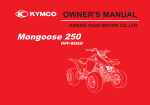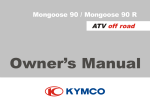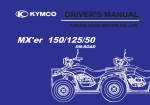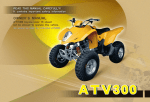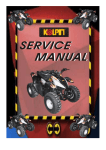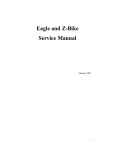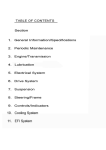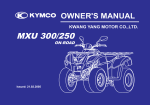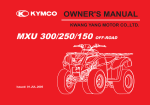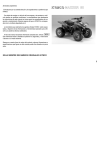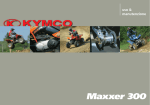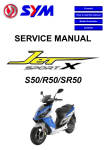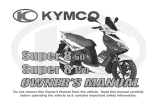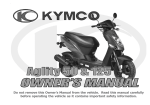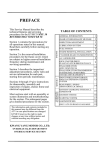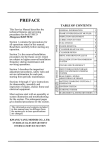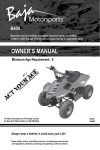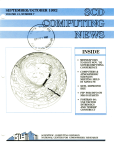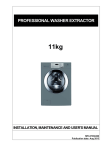Download Owners Manual
Transcript
IMPORTANT NOTICES READ THIS MANUAL CAREFULLY Your Owner's Manual contains important information on safety, operation, and maintenance. Any one who operates this ATV should carefully read and understand the contents of this manual before riding the vehicle. AGE RECOMMENDATION KXR 50: The minimum recommended age for this ATV model is 6. Children under age 6 should never operate this vehicle. KXR 90: The minimum recommended age for this ATV model is 12. Children under age 12 should never operate this vehicle. RIDER TRAINING Anyone who operates this vehicle should get proper instruction. FOR ON-ROAD USE ONLY This machine is designed and manufactured for ON-ROAD use only. It is illegal and unsafe to operate this machine on any hills and rough or loose terrain. This machine complies with all applicable ON-ROAD noise level and spark arrester laws and regulation in effect at the time of manufacture. Please check your local riding laws and regulations before operating this machine. A SPECIAL MESSAGES KYMCO provides many important safety messages both in this manual and on the vehicle. For your safety and the safety of others, pay special attention to all warnings preceded by this alert symbol . Failure to follow the warnings contained in this manual can result in SERIOUS INJURY or DEATH. WARNING Indicates a strong possibility that serious injury or death may result if instructions are not followed. CAUTION Indicates a possibility that equipment or property damage could result if instructions are not followed. Note: Gives helpful information The Owner's Manual should be considered a permanent part of your ATV. It should remain with the vehicle at all times and stay with the ATV if it is sold. B PREFACE Congratulations on your purchase of the KYMCO ATV. KYMCO take pride in a worldwide reputation for quality-in research, design, production and service. For replacement parts and accessories, we recommend genuine KYMCO products. They've been specially designed for your vehicle and manufactured to meet KYMCO's demanding standards. This manual will provide you with a good basic understanding of the features and operation of this machine. This manual includes important safety information. It provides information about special techniques and skills necessary to ride your machine. It also includes basic maintenance and inspection procedures. If you have any questions regarding the operation or maintenance of your machine, please consult a KYMCO dealer. We wish you many years of safe and enjoyable riding. While reading this manual, remember: WARNING Indicates a strong possibility that serious injury or death may result if instructions are not followed. All information in this publication is based on the latest product information available at the time of approval for printing. KWANG YANG MOTOR CO.,LTD reserves the right to make changes at any time without notice and without incurring any obligation. C CONTENTS Page LOCATION OF THE WARNING AND SPECIFICATION LABELS...........................1 Page Turn signal switch ................................23 Headlight switches ..............................24 Engine stop switch...............................25 Stater button.. . ....................................26 Kick starter.............. ..............................27 Remote engine stop switch.. ....................28 Throttle lever... .....................................29 Speed limiter.... .....................................30 Front and rear brake...............................31 Brake pedal (MAXXER 90)......................31 Parking brake ( MAXXER 50)....................32 Parking brake (MAXXER 90)...................33 Fuel tank cap .. .......................................34 Fuel valve . ........................................... 35 Locking steering ( MAXXER 90) ..............36 Starter (choke) (MAXXER 90).................37 Seat......................................................38 Flag pole bracket.................................... 39 Storage compartment . ...........................39 SAFETY INFORMATION.............................4 DESCRIPTION AND MACHINE IDENTIFICATION.......................................9 Key identification number.. ........................9 Frame and engine serial number...............10 Model code............................................10 Parts location...................................... 11 CONTROL FUNCTIONS........... ................16 Ignition switch....................................... .16 Indicator lamps ........... ...........................17 Instrument ....... .......... ...........................18 Handlebar switches................................23 Horn button................................. ........23 (Cont'd) D Page Page PRE-OPERATION CHECKS......................40 Front and rear brakes.............................41 Fuel .....................................................42 Engine (MAXXER 90) and transmission oil ....................................44 Engine oil ( MAXXER 50)....... ..................45 Chain ...................................................46 Throttle lever.........................................46 Fittings and fasteners.............................46 Lights ...................................................46 Switches .......................... ....................46 Tires ............................. .......................47 How to measure tire pressure .................48 Tire wear limit .......................................49 Riding Your ATV........................................59 GETTING TO KNOW YOUR ATV.. ...... ......60 RIDE WITH CARE AND GOOD JUDGEMENT.........................................61 Age Recommendation (MAXXER 50)........62 Age Recommendation (MAXXER 90)........63 Never carry passenger on the carrier........64 Apparel..... ...........................................65 Do not operate after consuming alcohol or drugs....................................................66 Pre-operation checks..............................67 Loading and accessories.........................69 Loading and Operational Guidelines.........69 Accessories...................... ....................70 No Modifications....................................71 During operation ...................................72 Exhaust system....................................74 RIDING................................................75 Remote engine stop switch for new Riders..................................................76 OPERATION............................................50 Starting a cold engine ( MAXXER 90)........50 Starting engine (MAXXER 50)................53 Engine break-in.....................................54 Parking .. ..............................................56 Parking on a slope .................................57 Accessories ..........................................58 (Cont'd) E Page Page Speed limiter for new riders.....................77 BRAKING..............................................78 TURNING YOUR ATV .............................79 CLIMBING UP SLOPE...........................80 RIDING DOWN SLOPE .........................86 PARKING..............................................87 WHAT TO DO IF....................................88 WHAT TO DO.......................................88 Front and rear brake shoes (drum brake) inspection...........................................110 Front brake lever free play adjustment....111 Rear brake lever free play adjustment (Drum brake)........................................113 Brake pedal adjustment (MAXXER 90)..115 Brake fluid inspection (Disk brake)........118 Drive chain slack check.........................120 Drive chain slack adjustment.................120 Drive chain cleaning and Lubrication......122 Cable inspection and lubrication...........122 Brake lever lubrication..........................123 Knuckle shaft and rear fork shaft lubrication...............................123 Draining the V-belt compartment (MAXXER 90)......................................123 Wheel removal.....................................124 Wheel installation.................................124 Battery .............................................125 Fuse replacement................................127 Headlight beam adjustment...................130 Troubleshooting ...............................131 Troubleshooting chart........................132 PERIODIC MAINTENANCE AND ADJUSTMENT.........................................89 Tool kit...................................................89 PERIODIC MAINTENANCE/ LUBRICATION ( MAXXER 50)..................91 PERIODIC MAINTENANCE/ LUBRICATION (MAXXER 90)..................93 Engine oil (MAXXER 90 )..........................95 Transmission oil.....................................99 Spark plug inspection............................102 Air filter cleaning..................................103 Valve clearance adjustment (MAXXER 90).....................................107 Idle speed adjustment.. ........................108 Throttle lever adjustment .....................109 (Cont'd) F Page CLEANING AND STORAGE.....................133 A. Cleaning .........................................133 B. Storage ...........................................135 SPECIFICATIONS (MAXXER 50)..............137 SPECIFICATIONS (MAXXER 90).............141 NOISE REGULATION.............................145 MAINTENANCE RECORD.......................146 INDEX...................................................147 G WARNING INFORMATION WARNING Your ATV comes with a hang tag and several labels containing important safety information. Anyone who rides the vehicle should read and understand this information before riding. Improper ATV use can result in SEVERE INJURY or DEATH. Parents of young riders should make sure their youngsters read and understand the hang tag and label information before allowing them to ride. ALWAYS USE AN APPROVED HELMET AND PROTECTIVE GEAR NEVER USE WITH ALCOHOL OR DRUGS NEVER operate : ‧Without proper training or instruction. ‧At speeds too fast for your skills or the conditions. Do not operate the vehicle after consuming ALCOHOL OR DRUGS. ALWAYS : ‧Use proper riding techniques to avoid vehicle overturns on hills and rough terrain and in turns. ‧For your safety, wear gear to include helmet gloves and foot protection. ‧Gasoline is flammable shut off engine, avoid sparks and open flame when refueling. The labels should be considered as permanent parts of the vehicle. If a label comes off or becomes hard to read, contact your KYMCO dealer for replacements READ OWNER'S MANUAL, FOLLOW ALL INSTRUCTIONS AND WARNINGS. 2 (MAXXER 50) (MAXXER 90) WARNING WARNING UNDER UNDER 6 12 Operating this ATV if you are under the age of 6 increases your chance of severe injury or death. Operating this ATV if you are under the age of 12 increases your chance of severe injury or death. NEVER operate this ATV if you are under age 6. NEVER operate this ATV if you are under age 12. WARNING IMPROPER TIRE PRESSURE OR OVERLOADING CAN CAUSE LOSS OF CONTROL. LOSS OF CONTROL CAN RESULT IN SEVERE INJURY OR DEATH. OPERATING TIRE PRESSURE : Set with tires cold‧ Recommended : FRONT : 22~28 kpa, (0.22~0.28 kgf/cm 2 ), 3.2~4.0 psi REAR : 22~28 kpa, (0.22~0.28 kgf/cm 2 ), 3.2~4.0 psi ‧Never set tire pressure over the recommended. 3 SAFETY INFORMATION AN ATV IS NOT A TOY AND CAN BE HAZARDOUS TO OPERATE. An ATV handles differently from other vehicles including motorcycles and cars. A collision can occur quickly, even during routine maneuvers, if you fail to take proper pre-cautions. SEVERE INJURY OR DEATH can result if you do not follow these instructions: ‧Read this manual and all labels carefully and follow the operating procedures described. ‧Never operate an ATV without proper training or instruction. Beginners should receive training from a certified instructor. ‧Always follow the age recommendation: - A child under 6 years old should never operate an ATV with engine size greater than 70cc. - A child under 12 years old should never operate an ATV with engine size greater than 90cc. ‧Never allow a child under age 16 to operate an ATV without adult supervision, and never allow continued use of an ATV by a child if he or she does not have the abilities to operate it safely. ‧Never operate an ATV without wearing an approved motorcycle helmet that fits properly. You should also wear eye protection (goggles or face shield), gloves, boots, long-sleeved shirt or jacket, and long pants. 4 ‧Never consume alcohol or drugs before or while operating this ATV. ‧Never operate at speeds too fast for your skills or the conditions. Always go at a speed that is proper for the terrain, visibility and operating conditions, and your experience. ‧Never attempt wheel, jump, or other stunt. ‧Always inspect your ATV each time you use it to make sure it is in safe operating condition. Always follow the inspection and maintenance procedures and schedules described in this manual. ‧Always keep both hands on the handlebars and both feet on the footboards of the ATV during operation. ‧Always go slowly and be extra careful when operating on unfamiliar terrain. Always be alert to changing terrain conditions when operating the ATV. ‧Never operate on excessively rough, slippery or loose terrain. ‧Always follow proper procedures for turning as described in this manual. Practice turning at low speeds before attempting to turn at faster speeds. Do not turn at excessive speed. ‧Never operate the ATV on hills. ‧Always follow proper procedures for climbing slopes as described in this manual. Check the terrain carefully before you start up any slope. Shift your weight forward. Never open the throttle suddenly. Never go over the top of a slope at high speed. 5 ‧Always follow proper procedures for going down slopes and for braking on slopes as described in this manual. Check the terrain carefully before you start down any slope. Shift your weight backward. Never go down a slope at high speed. Avoid going down slope at an angle that would cause the vehicle to lean sharply to one side. Go straight down the slope where possible. ‧Never attempt to turn the ATV around on any slope until you have mastered the turning technique described in this manual on level ground. Avoid crossing the side of a steep slope if possible. ‧Always check for obstacles before operating in a new area. Never attempt to operate over large obstacles, such as large rocks or fallen trees. Always follow proper procedures when operating over obstacles as described in this manual. ‧Always be careful when skidding or sliding. Learn to safely control skidding or sliding by practicing at low speeds and on level, smooth terrain. On extremely slippery surfaces, such as ice, go slowly and be very cautious in order to reduce the chance of skidding or sliding out of control. ‧Never operate an ATV in fast flowing water or in water deeper than that recommended in this manual. Remember that wet brakes may have reduced stopping ability. Test your brakes after leaving water. If necessary, apply them several times to let friction dry out the linings. ‧Always use the size and type tires specified in this manual. Always maintain proper tire pressure as described in this manual. ‧Never modify an ATV through improper installation or use of accessories. ‧Never exceed the stated load capacity for an ATV. Cargo should be properly distributed and securely attached. Reduce speed and follow instructions in this manual for carrying cargo. Allow greater distance for braking. 6 WARNING WHAT CAN HAPPEN Gasoline is poisonous and can cause injuries. HOW TO AVOID THE HAZARD If you should swallow some gasoline or inhale a lot of gasoline vapor, or get some gasoline in your eyes, see your doctor immediately. If gasoline spills on your skin, wash with soap and water. If gasoline spills on your clothing, change your clothes. POTENTIAL HAZARD Improper handling of gasoline. WHAT CAN HAPPEN Gasoline can catch fire and you could be burned. HOW TO AVOID THE HAZARD Always turn off the engine when refueling. Do not refuel right after the engine has been running and is still very hot. Do not spill gasoline on the engine or exhaust pipe/muffler when refueling. Never refuel while smoking, or while in the vicinity of sparks, open flames, or other sources of ignition such as the pilot lights of water heaters and clothes dryers. When transporting the machine in another vehicle, be sure it is kept upright and that the fuel cock is in the "OFF" position. Otherwise, fuel may leak out of the carburetor or fuel tank. 7 DESCRIPTION AND MACHINE IDENTIFICATION Keys identification number The keys identification number is stamped on the hang tag as shown in the following illustration. Identification number records Record the keys identification number, frame serial number, engine serial number and model code information for assistance when order replacement parts. IGNITION SWITCH KEY NO. STEERING LOCK KEY NO. (1) FRAME NO. (2) (1) Ignition switch key identification number (2) Steering lock key (MAXXER 90) identification number ENGINE NO. MODEL CODE 9 Headlight switch Turn the switch to the " the low beam. Turn the switch to the " the high beam. Turn the switch to the " the headlight. " position to switch on " position to switch on " position to switch off NOTE: (1) The headlight can be turned on only when the engine is running. (1) Headlight switch 24 Engine stop switch When the switch is in the RUN ( ) position, the engine will operate. When the switch is in OFF ( ) position, the engine will not operate. This switch is intended primarily as a safety or emergency control, and it should normally remain in the RUN ( ) position. (1) (1) Engine stop switch " "/" NOTE: If you stop your ATV by turning the engine stop switch OFF ( ), be sure to turn the ignition switch OFF to prevent battery discharge. " 25 Stater button To starter the engine, apply brake and press the starter button, with the ignition switch ON (‧) and the engine stop switch at RUN ( ) (1) CAUTION: See starting instructions prior to starting engine (see page 50 for details). NOTE: (1) Start button If the starter switch is pushed with the ignition switch "." and the engine stop switch " ", the starter motor will be activated but the engine will not start. To start the engine, be sure to position the engine stop switch at " ". 26 Throttle lever It is operated by the thumb. Pressing the lever opens the throttle. When pressure is released, spring tension automatically closes the throttle. Regulate the speed of the machine by varying the throttle position. WARNING POTENTIAL HAZARD Malfunction of throttle. WHAT CAN HAPPEN The throttle could be hard to operate, making it difficult to speed up or slow down when you need to. This could cause an accident. HOW TO AVOID THE HAZARD Check the operation of the throttle lever before you start the engine. If it does not work smoothly, check for the cause. Correct the problem before riding the ATV. Consult a KYMCO dealer if you can't find or solve the problem yourself. (1) (1) Throttle lever 29 Front and rear brakes The front and rear brakes are operated by squeezing the front brake lever. Brake pedal (MAXXER 90) The both front and rear brakes are operated at the same time by depressing the brake pedal. (1) (1) (1) Rear brake pedal (1) Front brake lever 31 Fuel tank cap After refueling, be sure to tighten the fuel tank cap. TO refuel refer to page 42~43. WARNING POTENTIAL HAZARD Improper use of the parking brake. WHAT CAN HAPPEN The ATV could start moving unexpectedly if the parking brake is not applied before starting the engine. This could cause loss of control or a collision. The brake could overheat if you ride the ATV without releasing the parking brake. You could lose braking performance which could cause an accident. You could also wear out the brakes prematurely. (1) HOW TO AVOID THE HAZARD Always set the parking brake before starting the engine. Always be sure you have released the parking brake before you begin to ride. (1) Fuel tank cap 34 Fuel valve The fuel valve supplies fuel from the fuel tank to the carburetor. The fuel valve has three positions. RES (2) OFF OFF: With the lever and " " mark in this position fuel will not flow. Always turn the lever to this position when the engine is ON : not running. With the lever " " mark in this position, fuel flows to the carburetor. Normal riding RES: is done with the lever in this position. This indicates reserve. If you run out of fuel while riding, turn the lever " " mark to this position. THEN FILL THE FUEL TANK AT THE FIRST OPPORTUNITY. After refueling, return the fuel valve lever to the "ON" position. ON (1) Fuel lever (2) " (1) " mark NOTE: After refueling, do not operate the ATV with the fuel valve in the RES position. If you run out of fuel, there will be no reserve supply. 35 Locking steering (MAXXER 90) Turn the steering handlebar left to full and turn the key clockwise, the steering handlebar is locked. The key can be taken out. Turn the key counterclockwise, the steering handlebar is released automatically. The key can be taken out. WARNING POTENTIAL HAZARD Improper use of the locking steering. WHAT CAN HAPPEN The ATV could cause loss of control or overturn. HOW TO AVOID THE HAZARD Always be sure you have released the locking steering handlebar before you begin to ride. Never lock the steering handlebar, when the engine is starting. Locking Unlocking 36 Starter (choke) ( MAXXER 90) Starting a cold engine requires a richer air-fuel mixture. A separate starter circuit supplies this mixture. Move in direction (A) to turn on the starter (choke). Move in direction (B) to turn off the starter (choke). Refer to "starting a cold engine" for proper operation. (See page 50.) CAUTION: ‧Extended use of the choke may impair piston and cylinder wall lubrication and shorten the life of the engine. ‧Pushing the choke knob too hard to the OFF position may dislodge the choke cable boot. If this happens, water and dirt may enter the choke cable and cause corrosion. If the choke is hard to actuate, or feels like it is sticking, Check the cable boot (B) (B) (A) (1) (1) Fully open (3) Closed (2) (3) (2) Half open (A) Starter (choke) 37 To install the seat, align the tabs on the seat with the grommets on the frame and press the seat down until it locks. Seat To remove the seat, pull upward the seat lock lever and pull up the seat the rear. NOTE: Make sure that the seat is securely fitted. (1) (1) (1) Seat lock lever 38 PRE-OPERATION CHECKS Before using this machine, check the following points: ITEM ROUTINE Brake ‧Check operation, condition, free play (drum brake) and brake fluid level (disk brake). ‧Adjust (drum brake) if necessary. ‧Fill with DOT 4 brake fluid (disk brake) if necessary. Fuel ‧Check fuel level. ‧Fill with fuel if necessary. Engine oil and Transmission oil ‧Check oil level. ‧Fill with oil if necessary. Drive chain ‧Check chain slack and condition. ‧Adjust if necessary. Throttle Wheels and tires Fittings and fasteners Switches Lights ‧Check for proper throttle cable operation. ‧Check tire pressure, wear and damage. ‧Check all fitting and fasteners. ‧Check for proper function. ‧Check for proper operation. 40 PAGE 41~42, 110~117 42~43 44~45, 95~101 46, 118~120 46 47~49, 122 46 46 46 Front and rear brakes 1. Drum brake Check for correct free play in the brake levers. If the free play is incorrect, adjust it. (See pages 110~117.) WARNING POTENTIAL HAZARD Failure to inspect the ATV before operating. Failure to properly maintain the ATV. Check operation of the levers. They should move smoothly and there should be a firm feeling when the brake is applied. If not, have the machine inspected by a KYMCO dealer. WHAT CAN HAPPEN Increases the possibillty of an accident or equipment damage. 2. Disk brake Make sure there is no brake fluid leakage. HOW TO AVOID THE HAZARD Always inspect your ATV each time you use it to make sure the ATV is in safe operating condition. Always follow the inspection and maintenance procedures and schedules described in the Owner's Manual. Check operation of the levers. They should move smoothly and there should be a firm feeling when the brake is applied. If not, have the machine inspected by a KYMCO dealer. 3. Brake operation Test the brakes at slow speed after starting out to make sure they are working properly. If the brakes do not provide proper braking performance, inspect the brakes for wear. (See page 110.) 41 Fuel Fill the fuel tank when necessary and make sure there is sufficient gasoline in the tank. Check for leaks. Fuel level should be below the filler neck. WARNING POTENTIAL HAZARD Riding with improperly operating brakes. WHAT CAN HAPPEN You could lose braking ability, which could lead to an accident. (1) HOW TO AVOID THE HAZARD Always check the brakes at the start of every ride. Do not ride the ATV if you find any problem with the brakes. If a problem cannot be corrected by the adjustment procedures provided in this manual, have the ATV inspected by a KYMCO dealer. (1) Filler neck Recommended fuel: UNLEADED FUEL Fuel tank capacity: Total: 5.5L(1.16 lmp gal, 1.4 US gal) Reserve: 1.5L(0.32 lmp gal, 0.38 US gal) 42 Your KYMCO engine has been designed to use regular unleaded gasoline with a pump octane number of 86 or higher, or research octane number of 91 or higher. If knocking or pinging occurs, use a different brand of gasoline or premium unleaded fuel. Unleaded fuel will give you longer spark plug life and reduced maintenance cost. Use unleaded fuel only because it produces fewer engine and spark plug deposits and extends the life of the exhaust system. Never use stale or contaminated gasoline or an oil/gasoline mixture. Avoid getting dirt, dust or water in the fuel tank. WARNING POTENTIAL HAZARD Improper care when refueling. WHAT CAN HAPPEN Fuel can spill, which can cause a fire and severe injury. Fuel expands when it heats up. If the fuel tank is overfilled, fuel could spill out due to heat from the engine. HOW TO AVOID THE HAZARD Do not overfill the fuel tank. Be careful not to spill fuel, especially on the engine or exhaust pipe. Wipe up any spilled fuel immediately. Be sure the fuel tank cap is closed securely. Do not refuel right after the engine has been running and is still very hot. 43 Engine ( MAXXER 90)and transmission oil Make sure the engine and transmission oil at the specified level. Add oil as necessary. (See page 95~101.) Check for leaks. 1 00 300 500 700 900 CAUTION: Be sure to use motor oils that do not contain anti-friction modifiers. Passenger car motor oils (often labeled "Energy Conserving") contain anti-friction additives which will cause starter clutch slippage, resulting in reduced component life and poor engine performance. 1100 F SAE 5W SAE 10W-30 SAE 10W-40 Oil quantity: Engine oil: Periodic oil change: 0.7 L (0.62 lmp qt, 0.74 US qt) Total amount: 0.8 L (0.70 lmp qt, 0.84 US qt) SAE 20W-40 SAE 20W-50 -1 00 00 100 200 300 Transmission oil: Periodic oil change: 0.11 L (0.10 lmp qt, 0.12 US qt) Total amount: 0.12 L (0.11 lmp qt, 0.13 US qt) 400 C Recommended engine/transmission oil classification: API Service SE, SF, SG type or higher 44 Engine oil ( MAXXER 50) Oil level When the low oil level indicator lights, it means the oil level in the oil tank is low; stop the engine and fill the oil tank as soon as possible. (1) CAUTION: (2) .If the low oil level indicator comes on while riding, stop riding and shut the engine off. Fill the oil tank to the upper level mark with the recommended oil. Continuing to ride with a low oil level may lead to engine failure that could result in an accident. .if the engine has been run after the low oil level indicator has come on, the scooter must be taken to an authorized KYMCO dealer for inspection and bleeding of the oil system. Failure to do this will result in serious engine damage. (3) (1) Cap (2) Upper level mark (3) Fill duct Oil recommendation : Use KYMCO 2-STROKE OIL OR ITS EQUIVALENT CAUTION: To fill, lift seat (see page 38), remove the cap from the oil tank, and fill with the recommended oil up to the upper level mark. The use of improper oils may cause excessive and/or premature carbon build-up in the engine and exhaust system, resulting in loss lf power and possible engine damage. Genuine KYMCO 2-Stroke Oil has been specifically designed and tested in KYMCO ATV and is a proper oil. NOTE: When filling, do not let dirt or other foreign materials enter the tank. 45 Chain Check the general condition of the chain and check the chain slack before every ride. Lubricate and adjust the chain as necessary. (See pages 118~120 for details.) Lights Check the position light and taillight/stop light to make sure they are in working condition. Repair as necessary for proper operation. Throttle lever Check to see that the throttle lever operates correctly. It must open smoothly and spring back to idle position when released. Repair as necessary for proper operation. Switches Check the operation of the taillight/stop light switch, engine stop switch, remote engine stop switch and any other switches. Repair as necessary for proper operation. Fittings and fasteners Always check the tightness of chassis fittings and fasteners before a ride. Take the machine to a KYMCO dealer or refer to the Service Manual for correct tightening torque. 46 2.The tires should be set to the recommended pressure: ‧Recommended tire pressure Tires WARNING 2 POTENTIAL HAZARD Operating this ATV with improper tires, or with improper or uneven tire pressure. Front: 25 kpa (0.25 kgf/cm , 3.6 psi) 2 Rear: 25 kpa (0.25 kgf/cm , 3.6 psi) ‧Check and adjust tire pressures when the tires are cold. ‧Tire pressures must be equal on both sides. WHAT CAN HAPPEN Use of improper tires on this ATV, or operation of this ATV with improper or uneven tire pressure, may cause loss of control, increasing your risk of accident. 3.Tire pressure below the minimum specified could cause the tire to dislodge from the rim under severe riding conditions. The following are minimums: HOW TO AVOID THE HAZARD 1.The tires listed below have been approved by Kwang Yang Motor Co., Ltd. for this model. Other tire combinations are not recommended. 2 Front: 22 kpa (0.22 kgf/cm , 3.2 psi) 2 Rear: 22 kpa (0.22 kgf/cm , 3.2 psi) Size Type MAXXER 50 MAXXER 90 18*7-8 16*8-7 TUBELESS Front Rear 16*8-7 18*9-8 TUBELESS 47 Set pressure tires cold. Set tire pressures to the following 4.Never set tire pressure over the recommended Front: 28 kpa (0.28 kgf/cm 2, 40 psi) Rear: 28 kpa (0.28 kgf/cm 2 , 40 psi) Higher pressures may cause the tire to burst. Inflate the tires very slowly and carefully. Fast inflation could cause the tire to burst. Recommended pressure Minimum Maximum Front 25 kpa (0.25 kgf/cm2, 3.6 psi) 22 kpa (0.22 kgf/cm2, 3.2 psi) 28 kpa (0.28 kgf/cm2, 4.0 psi) Rear 25 kpa (0.25 kgf/cm2, 3.6 psi) 22 kpa (0.22 kgf/cm2, 3.2 psi) 28 kpa (0.28 kgf/cm2, 4.0 psi) How to measure tire pressure Use the low-pressure tire gauge. NOTE: The low-pressure tire gauge is included as standard equipment. Make two measurements of the tire pressure and use the second reading. Dust or dirt in the gauge could cause the first reading to be incorrect. (1) Low-pressure tire gauge 48 Tire wear limit When the tire groove decreases to 3 mm (0.12 in) due to wear, replace the tire. A. 3mm (0.12 in) 49 Starting a cold engine (MAXXER 90 ) OPERATION WARNING WARNING POTENTIAL HAZARD Operating ATV without being familiar with all controls. POTENTIAL HAZARD Freezing control cables in cold weather. WHAT CAN HAPPEN You could be unable to control the ATV, which could lead to an accident or collision. WHAT CAN HAPPEN Loss of control, which could cause an accident or injury. HOW TO AVOID THE HAZARD When riding in cold weather, always make sure all control cables work smoothly before you begin riding. HOW TO AVOID THE HAZARD Read the Owner's Manual carefully. If there is a control or function you do not understand, ask your KYMCO dealer. 1. Select a level surface and lock the parking brake (see page 32 or 33) before starting the engine. 2. Turn the fuel lock to "ON". 3. Turn the main switch to "." and the engine stop switch to " ". 4. Make sure the tethered road lead is installed into the remote engine stop switch. 50 6.With the throttle closed, push the starter button. Release the starter button as soon as the engine starts. 5. Use the starter (choke) in reference to the figure: Position Position Position :Cold engine start-ambient temperature below 5C (40F). :Cold engine start-ambient temperature at 0C (30F)~30C(90F) and warming up position. :Cold engine start-ambient temperature above 25C(80F) and warm engine start position. NOTE: Do not use the electric starter for more than 5 seconds at a time. Release the starter button for approximately 10 seconds before pressing it again. 7. If the engine is started with the starter (choke) in position , the starter (choke) should be returned to position to warm up the engine. If the engine is started with the starter (choke) in position , keep the starter (choke) in this position to warm up the engine. 8. Continue warming up the engine until it idles smoothly and return the starter (choke) to position before riding. CAUTION: 1. Fully open 3. Closed See the "engine break-in section prior to operating engine for the first time. 2. Half open a. Starter (choke) 51 Starting a warm engine (MAXXER 90) To start a warm engine, refer to the "Starting a cold engine" section. The starter (choke) should not be used. The throttle should be opened slightly. To start the engine without the electric starter. 1. Follow steps 1 through 5. 2. With the throttle closed, operate the kick starter with a rapid, continuous motion. CAUTION: Warming up (MAXXER 90) To get maximum engine life, always warm up the engine before starting off. Never accelerate hard with a cold engine! To see whether or not the engine is warm, check if it responds to the throttle normally with the starter (choke) turned off. .Do not allow the kick starter to snap back freely against the pedal stop as engine case damage could result. .Raise the kick starter pedal after the kick starter lever is returned to the stop. 3. Follow steps 7 through 8. CAUTION: .Do not operate the throttle (open and close rapidly) as the ATV will move forward suddenly, causing possible loss of control. .Do not leave the ATV unattended while the engine is warming up 52 Starting engine (MAXXER 50) WARNING 5.With the throttle closed, push the starter button. Release the starter button as soon as the engine starts. POTENTIAL HAZARD Freezing control cables in cold weather. NOTE: Do not use the electric starter for more than 5 seconds at a time. Release the starter button for approximately 10 seconds before pressing it again. WHAT CAN HAPPEN You could be unable to control the ATV, which could lead to an accident or collision. HOW TO AVOID THE HAZARD When riding in cold weather, always make sure all control cables work smoothly before you begin riding. 6. Be sure to keep the throttle closed and the parking brake locked while starting and warming up the engine. 7. Allow the engine warm up before riding. 1. Select a level surface and lock the parking brake ( see page 32 or 33 ) before starting the engine. 2. Turn the fuel lock to "ON". 3. Turn the main switch to "." and the engine stop switch to " ". 4. Make sure the tethered road lead is installed into the remote engine stop switch. CAUTION: .Do not operate the throttle (open and close rapidly) as the ATV will move forward suddenly, causing possible loss of control. .Do not leave the ATV unattended while the engine is warming up 53 Engine break-in There is never a more important period in the life of your machine than the period between zero and 20 hours. For this reason, we ask that you carefully read the following material. Because the engine is brand new, you must not put an excessive load on it for the first 20 hours, the various parts in the engine wear and polish themselves to the correct operating clearances. During this period, prolonged full throttle operation or any condition which might result in excessive engine heating must be avoided. However, momentary (2~3 seconds maximum) full throttle operation under load does not harm the engine. Each full throttle acceleration sequence should be followed with a substantial rest period for the engine by cruising at lower r/min so the engine can rid itself of the temporary build up of heat. If any abnormality is noticed during this period, consult a KYMCO dealer. To start the engine without the electric starter. 1. Follow steps 1 through 4. 2. With the throttle closed, operate the kick starter with a rapid, continuous motion. CAUTION: .Do not allow the kick starter to snap back freely against the pedal stop as engine case damage could result. .Raise the kick starter pedal after the kick starter lever is returned to the stop. 3. Follow steps 6 through 7. If you cannot restart a warm engine: 1. Follow steps 1 through 4. 2. Open the throttle slightly (1/8-1/4) while starting the engine . If the throttle limiter Is adjusted as delivered, open the throttle fully. 54 1. 0~10 hours: Avoid continuous operation above half throttle. Allow a cooling off period of five to ten minutes after every hour of operation. Vary the speed of the machine from time to time. Do not operate it at full throttle position. 2. 10~20 hours: Avoid prolonged operation above 3/4 throttle. Rev the machine freely through the gears but do not use full throttle at any time. 3. After break-in Avoid prolonged full throttle operation. Vary speeds occasionally. 55 Parking ( MAXXER 50) When parking, stop the engine. Turn the fuel lock to "OFF" and apply the parking brake. Parking ( MAXXER 90) When parking, stop the engine. Turn the fuel lock to "OFF" and apply the parking brake. Make sure the lock plate into the locked position. Make sure the lock pin into the locked position. To set the parking brake, see page 33. To set the parking brake, see page 32. (1) (1) (1)Locked position (1)Locked position 56 Parking on a slope 1. Bring the machine to a stop by applying the brakes. 2. Stop the engine. 3. With the brake applied, apply the parking brake. WARNING POTENTIAL HAZARD Parking on a slope or other incline. WHAT CAN HAPPEN The ATV could roll out of control, increasing the chance of an accident. HOW TO AVOID THE HAZARD Avoid parking on slope or other inclines. If you must park on an incline, place the machine transversely across the incline, apply the parking brake, and block the front and rear wheels with rocks or other objects. Do not park the ATV at all on slope that are so steep you could not walk up them easily. 57 Accessories Accessories can affect the handling and control of your ATV. Keep the following in mind when considering an accessory or operating an ATV which has accessories. ‧Choose only accessories designed for your ATV. Your KYMCO dealer has a variety of genuine KYMCO accessories. Other accessories may also be available on the market. However, it is not possible for KYMCO to test all non-KYMCO accessories, nor have any control over the quality or suitability of them. Choose a genuine KYMCO accessory, or one that is equivalent in design and quality. ‧Accessories should be rigidly and securely mounted. An accessory which can shift position or come off while you are riding could affect your ability to control the ATV. ‧Do not mount an accessory where it could interfere with your ability your to control the ATV. Examples include (but are not limited to) a heavy or bulky object attached to the handlebars which could make steering difficult, an accessory that limits your ability to move around on the seat, or one that limits your view. ‧Use extra caution when riding an ATV with accessories. The ATV may handle differently 58 WARNING Indicates a potential hazard that could result in serious injury or death. GETTING TO KNOW YOUR ATV This ATV is for recreation and utility use. This section, riding your ATV, provides general ATV riding instructions for recreational riding. The skills and techniques described in this section, however, are appropriate for all types of riding. Riding your ATV requires special skills acquired through practice over a period of time. Take the time to learn the basic techniques well before attempting more difficult maneuvers. Manual completely and understand the operation of the controls. Pay particular attention to the safety information on pages 4~8. Please also read all caution and warning labels on your ATV. Riding your new ATV can be a very enjoyable activity, providing you with hours of pleasure. But it is essential to familiarize yourself with the operation of the ATV to achieve the skill necessary to enjoy riding safely. Before you begin to ride, be sure you have read this Owner's manual. 60 RIDE WITH CARE AND GOOD JUDGEMENT HOW TO AVOID THE HAZARD Become familiar with this ATV at slow speeds first, even if you are an experienced operator. Do not attempt to operate at maximum performance until you are totally familiar with the machine's handling and performance characteristics. Get training if you are inexperienced. Beginners and inexperienced riders should get proper instruction on how to operate this ATV. WARNING POTENTIAL HAZARD Operating this ATV without proper instruction. WHAT CAN HAPPEN The risk of an accident is greatly increased if the operator does not know how to operate the ATV properly in different situations and on different types of terrain. Riding your machine requires skills acquired through practice over a period of time. Take the time to learn the basic techniques well before attempting more difficult maneuvers. 61 Age Recommendation (MAXXER 50) The minimum recommended age for this ATV model is 6. For safety, never let children under 6 years old operate this vehicle. Children under 16 should be supervised by an adult. HOW TO AVOID THE HAZARD A child under 6 should never operate this ATV. Never allow a child under 16 to operate an ATV without adult supervision and never allow continued use of t e ATV by a child If he or she does not have the abilities to operate it safely. WARNING POTENTIAL HAZARD Failure to follow the age recommendations for this ATV. Failure to supervise children under 16 on ATV models intended for their use. UNDER WHAT CAN HAPPEN If children use ATVs that are not recommended for their age, severe injury or death can result. Even though a child may be within the age group for which an ATV is recommended, he or she may not have the skills, abilities, or judgment needed to operate the ATV safely and may be involved in a serious accident. 6 62 Age Recommendation (MAXXER 90) The minimum recommended age for this ATV model is 12. For safety, never let children under 12 years old operate this vehicle. Children under 16 should be supervised by an adult. HOW TO AVOID THE HAZARD A child under 12 should never operate this ATV. Never allow a child under 16 to operate an ATV without adult supervision and never allow continued use of t e ATV by a child If he or she does not have the abilities to operate it safely. WARNING POTENTIAL HAZARD Failure to follow the age recommendations for this ATV. Failure to supervise children under 16 on ATV models intended for their use. UNDER WHAT CAN HAPPEN If children use ATVs that are not recommended for their age, severe injury or death can result. Even though a child may be within the age group for which an ATV is recommended, he or she may not have the skills, abilities, or judgment needed to operate the ATV safely and may be involved in a serious accident. 12 63 Apparel Operating without protective clothing increases your chances of severe injury in the event of an accident. WARNING POTENTIAL HAZARD Operating this ATV without wearing an approved motorcycle helmet, eye protection and protective clothing. HOW TO AVOID THE HAZARD Always wear an approved motorcycle helmet that fits properly. WHAT CAN HAPPEN You should also wear: Operating without an approved motorcycle helmet increases your chances of a severe head injury or death in the event of an accident. eye protection(goggles or face shield) gloves boots long-sleeved shirt or jacket Long pants Operating without eye protection can result in an accident and increases your chances of a severe injury in the event of an accident. 65 Do not operate after consuming alcohol or drugs. Operator's performance capability is reduced by the influence of alcohol or drugs. WARNING POTENTIAL HAZARD Operating this ATV after consuming alcohol or drugs. WHAT CAN HAPPEN Could seriously affect your judgment. Could cause you to react more slowly. Could affect your balance and perception. Could result in an accident. HOW TO AVOID THE HAZARD Never consume alcohol or drugs before or while driving this ATV. 66 Pre-operation checks Always perform the pre-operation checks listed on page 40 before riding for safety and proper care of the machine. WARNING POTENTIAL HAZARD Operating this ATV with improper tires, or with improper or uneven tire pressure. WARNING POTENTIAL HAZARD Failure to inspect the ATV before operating. Failure to properly maintain the ATV. WHAT CAN HAPPEN Increases the possibility of an accident or equipment damage. WHAT CAN HAPPEN Use of improper tires on this ATV, or operation of this ATV with improper or uneven tire pressure, may cause loss of control, increasing your risk of an accident. HOW TO AVOID THE HAZARD Always inspect tour ATV each time you use it to make sure the ATV is in safe operating condition. Always follow the inspection and maintenance procedures and schedules described in the Owner's Manual. HOW TO AVOID THE HAZARD Always use the size and type tires specified in the Owner's Manual for this vehicle on pages47~48. Always maintain proper tire pressure as described in the Owner's Manual on page47. 67 Do not operate at speeds too fast your skills or the conditions. Speed limiter For riders inexperienced with this model, this model is equipped with a speed limiter in the throttle lever housing. The speed limiter limits the power and top speed of the machine. Turning the screw in decreases top speed, and turning it out increases top speed. WARNING POTENTIAL HAZARD Operating this ATV at speeds too fast for your skills or the conditions. WHAT CAN HAPPEN Increases your chances of losing control of the ATV, which can result in an accident. HOW TO AVOID THE HAZARD Always go at a speed that is proper for the terrain, visibility and operating conditions, and your experience. (2) 1. Adjuster 68 (1) 2. Locknut Loading and accessories Use extra caution when riding the machine with additional loads, such as accessories or cargo. The machine's handling may be adversely affected. Reduce your speed when adding additional loads. Loading and Operational Guidelines Carrying cargo will affect how your ATV handles and greatly reduce its ability in accelerating, braking and making turns and other maneuvers. Be sure to observe the weight limits and follow these guidelines: 1. Do not tow another vehicle. 2. Make sure all cargo is secured before riding. 3. Allow extra room for starting, stopping and turning whenever you carry cargo or pull a trailer. 4. Avoid riding on steep slopes when carrying cargo or pilling a trailer. 5. Never cross a slope when toeing a trailer. 69 Accessories Genuine KYMCO accessories have been specifically designed for and tested on this vehicle. Because KYMCO cannot test all other accessories, you are personally responsible for properly selecting, installing, and using nonKYMCO accessories. Always follow the loading instructions above, plus the following: WARNING POTENTIAL HAZARD Overloading this ATV or carrying or towing cargo improperly. WHAT CAN HAPPEN Could cause changes in vehicle handling, stability and braking which could lead to an accident. 1. Carefully inspect the accessory to make sure it does not block any lights, reduce ground clearance, or limit suspension travel, steering travel, or other controls. 2. Make sure the accessory does not interfere with your ability to shift body position on the seat or operate hand and foot controls. 3. Do not add electrical equipment that will exceed the vehicle's electrical system capacity. A blown fuse could cause a loss of lights or engine power. HOW TO AVOID THE HAZARD Never exceed the stated load capacity for this ATV. Cargo should be properly distributed and securely attached. Reduce speed when carrying cargo or pulling a trailer. Allow greater distance for braking. Always follow the instructions in your Owner's Manual for carrying cargo or pulling a trailer. 70 Modifications No Modifications Modifying this ATV or removing original equipment may render the vehicle unsafe or illegal. Spark arresters and mufflers are required in most areas. Don't modify your exhaust system or emission control system components. Remember, excessive noise bothers everyone and creates a bad image for ATV. WARNING POTENTIAL HAZARD Operating this ATV with improper modifications. WHAT CAN HAPPEN Improper installation of accessories or modification of this vehicle may cause changes in handling which in some situations could lead to an accident. HOW TO AVOID THE HAZARD Never modify this ATV through improper installation or use of accessories. All parts and accessories added to this vehicle should be genuine KYMCO or equivalent components designed for use on this ATV and should be installed and used according to instruction. If you have question, consult an authorized ATV dealer. 71 RIDING Select a flat area to become familiar with your ATV. Make sure that this area is free of obstacles and other riders. You should practice control of the throttle, brakes, shifting before trying more difficult terrain. WARNING POTENTIAL HAZARD Starting or running the engine in a closed area. WHAT CAN HAPPEN Exhaust fumes are poisonous and may cause loss of consciousness and death within a short time. Always avoid riding on rough surfaces: the ATV is designed for on-road use only, and handling maneuvers are more difficult to perform on level surfaces. HOW TO AVOID THE HAZARD Always operate your machine in an area with adequate ventilation. Set the parking brake and follow the instruction on page 50~54 to start the engine. Once it has warmed up you are ready to begin riding your ATV. Remember that the engine and exhaust pipe will be hot when riding and afterwards; do not allow skin or clothing to come in contact with these components. Practice with the remote engine stop switch and throttle limiter adjusted as delivered until you are confident in braking and making turns. 75 Speed limiter for new riders Your ATV has an adjustable throttle limiter. The screw and locknut in the lower throttle housing can be adjusted to limit throttle lever movement. To adjust the throttle limiter: 1. Loosen the lock nut. 2. Turn the throttle limiter screw clockwise to reduce throttle lever movement or counterclockwise to increase throttle lever movement. 3. Hole the screw in place and tighten the lock nut. (2) 1. Adjuster 77 (1) 2. Locknut BRAKING Practice starting and stopping at slow speeds. Gradually work up to faster starts and stops. Pulling one or both brake levers or/and depressing brake pedal too hard may cause the front and/or rear wheels to skid or slide out of control. If this happens, release all pressure on the lever(s) immediately. Steer straight ahead to regain control. Then gently reapply the brakes. 1. Steer straight ahead. Close the throttle completely, remove your thumb from the throttle lever. 2. Gently apply the brakes: pull both hand levers. Independent use of only the front or rear brakes reduces stopping performance. Extreme braking may cause the wheels to lock, reducing control of the ATV Gradually increase the lever or/and pedal pressure as you feel the brakes slowing your speed. The pressure used depends on your speed and the condition of the terrain you are riding. Slick , slippery or muddy ground requires gentler braking. When possible, reduce speed or brake before entering a turn. Closing the throttle or braking in mid-turn may cause wheel slippage which will reduce control of your ATV. 78 CLIMBING UP SLOPE Use proper riding techniques to avoid vehicle overturns on slopes. Be sure that you can maneuver your ATV well on flat ground before attempting any incline and then practice riding first on gentle slopes. Try more difficult climbs only after you have developed your skill. In all cases avoid inclines with slippery or loose surfaces, or obstacles that might cause you to lose control. WARNING POTENTIAL HAZARD Operating on excessively steep slopes. WHAT CAN HAPPEN The vehicle can overturn more easily on extremely steep slopes than on level surfaces or small slopes. HOW TO AVOID THE HAZARD Never operate the ATV on slopes too steep for the ATV or for your abilities. Practice on smaller slopes before attempting large slopes. It is important when climbing a slope to make sure that tour weight is transferred forward on the ATV. This can be accomplished by leaning forward, steeper inclines and standing on the footboards and leaning forward over the handlebars. 80 If your ATV has stalled or stopped and you believe you can continue up the slope, restart carefully to make sure you do not lift the front wheels which could cause you to lose control. If you are unable to continue up the slope, dismount the ATV on up slope side. Physically turn the ATV around and then descend the slope. WARNING POTENTIAL HAZARD Stalling, rolling backwards or improperly dismounting while climbing a slope. WHAT CAN HAPPEN Could result in ATV overturning. HOW TO AVOID THE HAZARD Maintain steady speed when climbing a slope. If you start to roll backwards, DO NOT use the rear brake to stop. The ATV could easily tip over backwards. Instead, dismount the ATV immediately on the up of slope side. If you lose all forward speed: Keep weight up slope. Apply the brakes. Lock parking brake, after you are stopped. If you begin rolling backwards: Keep weight up slope. Never apply the rear brake while rolling backwards. 83 RIDING DOWN SLOPE When riding your ATV down slope, shift your weight as far to the rear and up slope side of the ATV as possible. Move back on the seat and sit with your arms straight. Improper braking may cause a loss of traction. Use caution while descending a slope with loose or slippery surfaces. Braking ability and traction may be adversely affected by these surfaces. Improper braking may also cause a loss of traction. Whenever possible, ride your ATV straight down slope. Avoid sharp angles which could allow the ATV to tip or roll over. Carefully choose your path and ride no faster than you will be able to react to obstacles which may appear. WARNING POTENTIAL HAZARD Going down a slope improperly. WHAT CAN HAPPEN Could cause loss of control or cause the ATV to overturn. HOW TO AVOID THE HAZARD Always follow proper procedures for going down slopes as described in this Owner's Manual. Note: a special technique is required when braking as you go down a slope. Always check the terrain carefully before you start down any slope. Shift your weight backward. Never go down a slope at high speed. Avoid going down a slope at an angle that would cause the vehicle to lean sharply to one side. Go straight down the slope where possible. 86 WHAT TO DO IF This section is designed to be a reference guide only. Be sure to read each section on riding techniques completely. If your ATV can't make it up a slope you are trying to climb: Turn the ATV around if you still have forward speed. If not, stop, dismount on the up slope side of the ATV and physically turn the ATV around. If the ATV starts to slip backwards DO NOT USE THE REAR BRAKE - the ATV may tip over on top of you. Dismount the ATV on the up slope side. (See pages 80~85.) WHAT TO DO.... If your ATV doesn't turn when you want it to: Bring the ATV to a stop and practice the turning maneuvers again. Be sure you are putting your weight on the footboard to the outside of the turn. Position your weight over the front wheels for better control. (See pages 79.) 88 PERIODIC MAINTENANCE AND ADJUSTMENT Have KYMCO dealer perform service if you are not familiar with machine service. Periodic inspection, adjustment and lubrication will keep your machine in the safest and most efficient condition possible. Safety is an obligation of the machine owner. The most important points of machine inspection, adjustment and lubrication are explained on the following pages. Tool kit A tool kit is provide with your ATV. You are recommended to put the tool kit in the vinyl bag and always carry them on the seat reverse side. WARNING POTENTIAL HAZARD Servicing an engine while it is running. WHAT CAN HAPPEN Moving parts can catch clothing or parts of the body, causing injury. Electrical components can cause shocks or can start fires. (2) (1) (1) Tool kit HOW TO AVOID THE HAZARD Turn off the engine when performing maintenance unless otherwise specified. 89 (2) Rubber band The tools in the kit are sufficient to perform routine maintenance and simple repairs. Any extensive work requiring additional tools should be performed by your authorized KYMCO dealer. WARNING POTENTIAL HAZARD Operating this ATV with improper modifications. The tool kit includes the following items: (1) Air pressure gauge (2) Spark plug wrench (3) Standard/Phillips screwdriver (4) Screwdriver handle (5) 10/12 mm wrench (6) Tool bag (7) Rubber band (1) (2) (3) (4) (5) (6) WHAT CAN HAPPEN Improper installation of accessories or modification of this vehicle may cause changes in handling which in some situation could lead to an accident. HOW TO AVOID THE HAZARD Never modify this ATV through improper installation or use of accessories. All parts and accessories added to this vehicle should be genuine KYMCO or equivalent components designed for use on this ATV and should be installed and used according to instructions. If you have questions, consult an authorized KYMCO dealer. (7) 90 PERIODIC MAINTENANCE/LUBRICATION (MAXXER 50) ITEM Drive chain Fuel line* Transmission oil V-belt* Air filter element Brake* Battery* Carburetor* Wheels* Spark plug Exhaust system* ROUTINE 1 month INITIAL EVERY 1 3 6 6 months months months year ‧Check and adjust slack/alignment/clean/lube. ‧Check fuel hose for cracks or damage. ‧Replace if necessary. ‧Check oil level/oil leakage. ‧Replace every 12 months. ‧Check operation. ‧Replace if damage or excessive wear. ‧Clean. ‧Replace if necessary. Every 20~40 hours (More often in wet or dusty areas.) ‧Check operation and brake fluid/cable. ‧Replace brake pads/shoes if necessary. ‧Check specific gravity if necessary. ‧Check breather hose for proper operation if necessary. ‧Correct if necessary. ‧Check idle speed/starter operation. ‧Adjust if necessary. ‧Check balance/damage/runout. ‧Replace if necessary. ‧Check condition. ‧Adjust gap and clean. ‧Replace if necessary. ‧Check leakage. ‧Retighten if necessary. ‧Replace gasket if necessary. 91 ITEM Wheel bearings* Steering system* ROUTINE 1 month ‧Check bearing assembly for looseness/damage. ‧Replace if damaged. ‧Check operation. ‧Replace if damaged. ‧Check toe-in. ‧Adjust if necessary. Knuckle shafts/ Steering shaft* ‧Lubricate every 6 months. Fittings and Fasteners* ‧Check all chassis fittings and fasteners. ‧Correct if necessary. * : It is recommended that these items be serviced by a KYMCO dealer. ** : Lithium soap base grease. 92 INITIAL EVERY 1 3 6 6 months months months year PERIODIC MAINTENANCE/LUBRICATION (MAXXER 90) ITEM Engine oil Oil strainer* Transmission oil V-belt* Air filter element (for engine and V-belt compartment) ROUTINE 1 month ‧Replace (Warm engine before draining). ‧Clean. ‧Replace if necessary. ‧Check oil level/oil leakage. ‧Replace every 12 months. ‧Check operation. ‧Replace if damage or excessive wear. ‧Clean. ‧Replace if necessary. Every 20~40 hours (More often in wet or dusty areas.) Cylinder head cover breather system* ‧Check operation and brake fluid/cable. ‧Replace brake pads/shoes if necessary. ‧Check specific gravity. ‧Check breather hose for proper operation. ‧Correct if necessary. ‧Check idle speed/starter operation. ‧Adjust if necessary. ‧Check breather hose for cracks or damage. ‧Replace if necessary. Drive chain ‧Check and adjust slack/alignment/clean/lube. Brake* Battery* Carburetor* Spark plug Fuel line* INITIAL EVERY 1 3 6 6 months months months year ‧Check condition. ‧Adjust gap and clean. ‧Replace if necessary. ‧Check fuel hose for cracks or damage. ‧Replace if necessary. 93 ITEM Valves* Exhaust system* Wheels* Wheel bearings* Steering system* ROUTINE 1 month ‧Check valve clearance. ‧Adjust if necessary. ‧Check leakage. ‧Retighten if necessary. ‧Replace gasket if necessary. ‧Check balance/damage/runout. ‧Replace if necessary. ‧Check bearing assembly for looseness/damage. ‧Replace if damaged. ‧Check operation. ‧Replace if damaged. ‧Check toe-in. ‧Adjust if necessary. Knuckle shafts/ Steering shaft* ‧Lubricate every 6 months. Fittings and Fasteners* ‧Check all chassis fittings and fasteners. ‧Correct if necessary. * : It is recommended that these items be serviced by a KYMCO dealer. ** : Lithium soap base grease. 94 INITIAL EVERY 1 3 6 6 months months months year Engine oil ( MAXXER 90) 1.Engine oil level measurement A. Place the machine on a level place. B. Warm up the engine for several minutes and stop it. C. Remove right side cover. E. Remove the dipstick and inspect the oil level. F. The oil level should be between the maximum and minimum marks. If the level is low, add oil to raise it to the proper level. (1) (2) (3) (1) (1) Dipstick/oil filler cap (3) Minimum level mark (1) Right side cover D. Remove the dipstick and wipe it off with a clean rag. Insert the dipstick in the filler hole without screwing it in. (2) Maximum level mark CAUTION: Be sure no foreign material enters the crankcase. NOTE: Wait a few minutes until the oil level settles before checking. 95 2-1. Engine oil replacement and oil filter cleaning A. Place the machine on a level place. B. Warm up the engine for several minutes and stop it. C. Place a container under the engine. D. Remove the oil filler cap and oil filter cap to drain the oil. CAUTION: .Be sure no foreign material enters the crankcase. .When removing the drain plug, the compression spring, oil strainer and Oring will fall out. Take care not to lose these parts. E. Clean the oil strainer with solvent. F. Inspect the O-ring and replace if damaged. G. Reinstall the O-ring, oil strainer, compression spring and drain plug. Tighten the drain plug to specification. CAUTION: (1) Before reinstalling the drain plug, be sure to install the O-ring, compression spring and oil strainer. (1) Oil filter cap Tightening torque: Oil filter cap (engine): 14.7 Nm (1.5 m-kg, 10.6 ft-lb) 96 H. Fill the engine with oil and install the oil filler cap. 2-2. Engine oil replacement A. Place the machine on a level place. B. Warm up the engine for several minutes and stop it. C. Place a container under the engine. D. Remove the oil filler cap and drain plug to drain the oil. Recommended oil: see page 136. Oil quantity: Engine oil: Periodic oil change: 0.7 L (0.62 lmp qt, 0.74 US qt) Total amount: 0.8 L (0.70 lmp qt, 0.84 US qt) (1) CAUTION: Be sure no foreign material enters the crankcase. I. Warm up the engine for several minutes at idle speed. Check for oil leakage while warming up. CAUTION: (1) Dipstick/oil filler cap If oil leakage is found, stop the engine immediately and check for the cause. CAUTION: Be sure no foreign material enters the crankcase. 97 Tightening torque: Drain plug (engine): 30 Nm (3.0 m-kg, 21.6 ft-lb) CAUTION: Be sure no foreign material enters the crankcase. (1) Recommended oil: see page 142. Oil quantity: see page 142. (1) Drain plug E. Reinstall the drain plug and tighten the drain plug to specification. F. Fill the engine with oil and install the oil filler cap. G. Warm up the engine for several minutes at idle speed. Check for oil leakage while warming up. 98 Transmission oil 1. Transmission oil measurement A. Place the machine on a level place. B. Remove the oil filler bolt and check the oil level. It should be up to the brim of the hole. If the level is low, add oil to raise it to the proper level. C. Reinstall the oil filler bolt and tighten to specification. (1) Tightening torque Oil filler bolt: 15 Nm (1.5 m-kg, 11 ft-lb) (1) Oil filler bolt/measurement hole (MAXXER 50) (1) (1) Oil filler bolt/measurement hole (MAXXER 90) 99 2. Transmission oil replacement A. Place the machine on a level place. B. Place a container under the engine. C. Remove the oil filler bolt and drain plug to drain the oil. D. Reinstall the drain plug and tighten to Specification. (1) Tightening torque Drain plug: 15 Nm (1.5 m-kg, 11 ft-lb) 1. Drain plug (MAXXER 50) (1) (1) Drain plug (MAXXER 90) 100 E. Fill the engine with oil and install the oil filler bolt. (1) Recommended oil : See page 138 or 142 Oil quantity: Periodic oil change: 0.11L (0.10Imp qt, 0.12US qt) Total amount: 0.12L (0.11Imp qt, 0.13US qt) CAUTION: Be sure no foreign material enters the crankcase. 1. Oil filler bolt (MAXXER 50) Tightening torque Oil filler bolt: 15 Nm (1.5 m-kg, 11 ft-lb) (1) F. Start the engine and warm up for a few minutes. While warming up, check for oil leakage. If oil leakage is found, stop the engine immediately and check for the cause. (1) Oil filler bolt (MAXXER 90) 101 Spark plug inspection The spark plug is an important engine component and is easy to inspect. The condition of the spark plug can indicate the condition of the engine. For example, a very white center electrode porcelain color could indicate an intake air leak or carburetion problem for that cylinder. Do not attempt to diagnose such problems yourself. Instead, take the machine to a KYMCO dealer. You should periodically remove and inspect the spark plug because heat and deposits will cause the spark plug to slowly break down and erode. If electrode erosion becomes excessive, you should replace the spark plug with one of the proper type. Standard spark plug: MAXXER 50: NGK BR8HAS MAXXER 90: NGK C7HSA Before installing the spark plug, measure the electrode gap with a feeler gauge and adjust to specification. Spark plug gap: 0.6~0.7 mm (0.024~0.028 in) A. Spark plug gap When installing the spark plug, always clean the gasket surface and use a new gasket. Wipe off any grime from the threads and tighten to the specified torque. Tightening torque: Spark plug: 12.5 Nm (1.25 m.kg, 9.1 ft.lb) 102 Air filter cleaning The air cleaner accumulates dust and must be cleaned periodically. If the ATV is ridden in dusty areas, the air cleaner must be cleaned at more frequent intervals than specified in the Maintenance Schedule. If the ATV is submerged in water, the air cleaner should be checked and water should be drained from the air cleaner housing before starting the engine. To clean the air cleaner (MAXXER 90): 1. Remove the seat. (See page 38.) 2. Remove the air filter case cover. (1) (1) Air filter case cover 103 3. Remove the air filter element, and separate it from the box. WARNING POTENTIAL HAZARD Using low flash point solvents or gasoline to clean the air filter element. WHAT CAN HAPPEN Low flash point solvents or gasoline can catch fire or explode. HOW TO AVOID THE HAZARD Use parts cleaning solvent to clean the air filter element. (1) (1) Air filter element 4. Wash the element gently but thoroughly in solvent. 5. Squeeze the excess solvent out of the filter and let it dry. CAUTION: Do not twist the filter element when squeezing it. 104 6. Inspect the element. If damaged, replace it. 7. Apply quality foam air filter oil to the element. If foam air filter oil is not available, motor oil may be used. To clean the air cleaner (MAXXER 50): 1. Remove the air filter case cover. NOTE: The element should be wet but not dripping. 8. Reinstall the element to the air filter case . 9. Reinstall the element assembly and parts removed for access. (1) (1) Air filter case cover 105 2. Remove the air filter element, and separate it from the box. WARNING POTENTIAL HAZARD Using low flash point solvents or gasoline to clean the air filter element. WHAT CAN HAPPEN Low flash point solvents or gasoline can catch fire or explode. HOW TO AVOID THE HAZARD Use parts cleaning solvent to clean the air filter element. (1) (1) Air filter element 3. Wash the element gently but thoroughly in solvent. 4. Squeeze the excess solvent out of the filter and let it dry. CAUTION: Do not twist the filter element when squeezing it. 106 5. Inspect the element. If damaged, replace it. 6. Apply quality foam air filter oil to the element. If foam air filter oil is not available, motor oil may be used. NOTE: Valve clearance adjustment ( MAXXER 90) The correct valve clearance changes with use, resulting in improper fuel/air supply or engine noise. To prevent this, the valve clearance must be adjusted regularly. This adjustment however, should be left to a professional KYMCO service technician. The element should be wet but not dripping. 7. Reinstall the element to the air filter case . 8. Reinstall the element assembly and parts removed for access. 107 Idle speed adjustment NOTE: A diagnostic tachometer must be used for this procedure. (1) 1. Start the engine and warm it up for a few minutes at approximately 1,000 to 2,000 r/min. Occasionally rev the engine to 4,000 to 5,000 r/min. The engine is warm when it quickly responds to the throttle. 2. Connect the tachometer and set the idle to the specified idling speed by adjusting the throttle stop screw. Turn the screw in to increase engine speed, and out to decrease engine speed. 1. Throttle stop screw Specified idle speed: MAXXER 50: 2000 RPM MAXXER 90: 1700 RPM 108 Throttle lever adjustment (1) NOTE: Adjust the engine idling speed before adjusting the throttle lever free play. (3) (2) (4) (A ) To adjust throttle free play: 1. Slide the rubber sleeves back to expose the throttle cable adjuster. 2. Loosen the lock nut, then turn the adjuster to obtain the correct free play. (1~4 mm or 0.04~0.16 in) 3. Tighten the locknut and reinstall the sleeve. (1) (1) Rubber sleeve (2) Cable adjuster (3) Locknut (4) Throttle lever (A) 1~4 mm (0.04~0.16 in) Other checks: Check the throttle cable for kinks and signs of wear that could cause stretching or failure. Lubricate the throttle cable with a commercially available lubricant to prevent premature wear and corrosion. 109 Front and rear brake shoes (drum brake) inspection When turn the adjusting nut fully to decrease brake lever free play and the free play and the free play exceeds the specification (1~2cm), it means the brake shoe is worn out. Go to our designated distributors or service stations for brake shoe replacing. Rear brake pads inspection (Disk brake) A wear indicator is provided on each brake. The indicators allows checking of brake pads wear. Check the position of the indicator. If the indicator reaches the wear limit line, ask a KYMCO dealer to replace the pads. (1) (2) (1) Wear indicator 110 (2) Rear brake Front brake lever free play adjustment The front brake lever free play should be adjusted to 10~20 mm (0.4~0.8 in) at the tip of the brake lever. If the free play is incorrect, adjust as follows: (2) (A) (1) (3) (1) Upper locknut (3) Lower locknut (2) Upper adjusting bolt (4) Lower adjusting bolt 2. Loosen the lower locknut. 3. Turn the lower adjusting bolt until specified free play is obtained. (A) Free play 10~20 mm (0.4~0.8 in) Specified free play: 10~20 mm (0.4~0.8 in) 1. Loosen the upper locknut and fully turn in the adjusting bolt. 4. Tighten the lower locknut. 111 (4) 5. While applying the front brake, turn out the upper adjusting bolt until the upper and lower cable lengths are equal. The cable joint will become vertical. WARNING POTENTIAL HAZARD Operating with improperly serviced or adjusted brakes. (A) WHAT CAN HAPPEN You could lose braking ability, which could lead to an accident. (1) HOW TO AVOID THE HAZARD After servicing: ‧Make sure the brakes operate smoothly and that the free play is correct. ‧Make sure the brakes do not drag. Replacement of brake components requires professional knowledge. These procedures should be performed by KYMCO dealer. (A) (1) Cable joint ( A) Cable length 6. Tighten the upper locknut. 112 Turn the adjusting nut on the brake hub in direction A to decrease play, and in direction B to increase play. (A) Rear brake lever free play adjustment (Drum brake) The rear brake lever free play should be adjusted to 10~20 mm (0.4~0.8 in) at the tip of the brake lever. If the free play is incorrect, adjust as follows: (B) (A) (1) A. Free play 10~20 mm (0.4~0.8 in) (1) Adjusting nut (A) Decrease play (B) Increase play 113 NOTE: WARNING Make sure the cut-out on the adjusting nut Is seated on the brake arm pin after making final free play adjustment. POTENTIAL HAZARD Operating with improperly serviced or adjusted brakes. WHAT CAN HAPPEN You could lose braking ability, which could lead to an accident. (1) (1) Arm pin HOW TO AVOID THE HAZARD After servicing: ‧Make sure the brakes operate smoothly and that the free play is correct. ‧Make sure the brakes do not drag. Replacement of brake components requires professional knowledge. These procedures should be performed by KYMCO dealer. (2) (2) Adjusting nut 114 Brake pedal adjustment (MAXXER 90) The brake pedal free play should be adjusted to 5~10 mm (0.2~0.4 in) at the brake pedal pivot. If the free play is incorrect, adjust as Follows: 3. Turn the adjusting bolts until the front Lower brake cables is tensed. 4. Apply the front brake lever and check front brake cam levers to make sure that the brake does not drag after adjusting. (A) (2) (1) (1) (2) (A) 5~10 mm (0.2~0.4 in) Adjust: 1. Keep front brake lever free play at 10~20 mm (0.4~0.8 in). 2. Loosen the locknuts. (R/L front lower brake cables) (1) Adjusting bolts (2) Locknuts 115 (1) R/L front lower cables (2) Brake cam lever 5. While remove the cable joint case cover and applying the brake pedal, make sure the left and right front lower cable lengths (A and B) are equal. The cable joint will become vertical. 6. Tighten the locknuts. (R/L front lower brake 7. Loosen the locknut. (Brake pedal cable) 8. Turn the adjusting bolt until the specified free play is obtained. Specified free play: 5~10 mm (0.2~0.4 in) 9. Tighten the locknut. (Brake pedal cable) (1) (A) (3) (2) (1) (1) Bolts (2) Cable joint case cover (1) (B) (1) Cable joint (A) Left front lower cable length (B) Right front lower cable length (2) (1) Locknut (2) Adjusting bolt (3) Brake pedal cable 116 WARNING POTENTIAL HAZARD Operating with improperly serviced or adjusted brakes. WHAT CAN HAPPEN You could lose braking ability, which could lead to an accident. HOW TO AVOID THE HAZARD After servicing: ‧Make sure the brakes operate smoothly and that the free play is correct. ‧Make sure the brakes do not drag. Replacement of brake components requires professional knowledge. These procedures should be performed by KYMCO dealer. 117 Brake fluid inspection (Disk brake) Check if the fluid level is below the lower level mark through the brake fluid reservoir (under the rear fender right side). (1) WARNING POTENTIAL HAZARD Brake fluid contacting the skink or eyes. WHAT CAN HAPPEN May cause irritation. HOW TO AVOID THE HAZARD Avoid contacting brake fluid with the skin or eyes. In case of contact, flush thoroughly with water and call a doctor if your eyes were exposed. (A) UPPER (B) LOWER (1) Brake fluid reservoir (A) Upper level mark (B) Lower level mark 118 NOTE: CAUTION: ‧As the brake pads wear, brake fluid level drops, automatically compensating for wear. There are no adjustments to perform, but fluid level and pad wear must be inspected periodically. The system must be inspected frequently to ensure there are no fluid leaks. ‧If the brake lever travel become excessive and the brake pads are not worn beyond the recommended limit (page 110), There is probably air in the brake system and it must be bled. See your authorized KYMCO dealer for this service. ‧To prevent damage to the brake system, use only fluid from a sealed container. Never allow contaminants (dirt, water, etc.) to enter the brake fluid reservoir. ‧Brake fluid can damage paint and plastic, so handle the fluid with care. When adding brake fluid, be sure the reservoir is horizontal before removing the cover to prevent accidental spilling. ‧Use only DOT 4 brake fluid from a sealed container. 119 Drive chain slack check Inspect the drive chain while all tires are touching the ground. Check the slack at the position shown in the figure. The normal vertical deflection is approximately 10~20 mm (0.4~0.8in). If the deflection exceeds 20 mm (0.8 in), adjust the chain slack. Drive chain slack adjustment 1.Loosen the upper and lower axle holding (2) 1. Hub stopper nut (A) A. 10~20 mm (0.4~0.8 in) 120 2. Axle holding bolt x 4 2.Turn the adjusting nut, to decrease or increase chain slack. 3.Retighten the upper and lower axle holding bolts. Tightening torque: Axle holding bolts (upper): 70 Nm (7.0 m-kg, 48 ft-lb) (1) 1. Adjust nut CAUTION: Too little of chain slack will overload the engine and other important parts. Keep the slack within the specified limit. 121 Drive chain cleaning and lubrication The drive chain is equipped with rubber O-rings between the chain plates. Steam cleaning, highpressure washes, and certain solvents can damage these O-rings. Use only kerosene to clean the drive chain. Wipe it dry, and thoroughly lubricate it with SAE 30~50 motor oil. Do not use any other lubricants on the drive chain. They may contain solvents that could damage the O-rings. Cable inspection and lubrication WARNING POTENTIAL HAZARD Damaged control cables. WHAT CAN HAPPEN Corrosion can result when the outer covering of control cables becomes damaged. Cables can also become frayed or kinked. Operation of controls could be restricted, which could cause an accident or injury. HOW TO AVOID THE HAZARD Inspect cables frequently. Replace damaged cables. Lubricate the inner cables and the cable ends. If the cables do not operate smoothly, ask a KYMCO dealer to replace them. Recommended lubricant: KYMCO chain and cable lube or SAE 10W40 motor oil 1. O-rings 122 Brake lever lubrication Lubricate the pivoting parts of the brake levers. Recommended lubricant: Lithium-soap-based grease (All-purpose grease) Knuckle shaft and rear fork shaft lubrication Lubricate the pivot points using a grease gun. Draining the V-belt compartment ( MAXXER 90) If water leaks into V-belt compartment such as when the machine is drive in water, remove the drain screw on the bottom of compartment and drain the water. Be sure to drive slowly until the V-belt becomes dry. If slipping is noticed, ask a KYMCO dealer to inspect. Recommended lubricant: Lithium-soap-based grease (1) (1) Drain bolt 123 Wheel removal 1. Elevate the wheel by placing a suitable stand under the frame. 2. Remove the nuts from the wheel. 3. Remove the wheel assembly. Wheel nut torque: Front: 40 Nm (4.0 m-kg, 30 ft-lb) Rear: 40 Nm (4.0 m-kg, 30 ft-lb) (1) (1) Safe nut Wheel installation When installing the wheel, reverse the removal procedure. Pay attention to the following. 124 Battery Your ATV battery is located in a compartment under the seat. The battery is sealed, so it is not necessary to check the electrolyte level or add distilled water. If the battery seems weak, see your authorized KYMCO dealer for information on recharging or replacement. If you replace the battery, choose one that is sealed and equivalent to the original. Be sure to read and follow all safety precautions indicated on the battery. WARNING POTENTIAL HAZARD Allowing open flames or sparks near the battery. WHAT CAN HAPPEN Gases may explode and possibly cause injury. HOW TO AVOID THE HAZARD Do not allow open flames or sparks near the battery. CAUTION: ‧Do not attempt to remove the caps from the battery cells as this may damage the battery. ‧Although the battery is sealed, it vents explosive gases and should be handled with appropriate care. NOTE: ‧When the ATV is to be stored for an extended period, remove the battery from the vehicle and charge it fully. Then store it in a cool, dry place. If the battery is to be left on the vehicle, disconnect the negative cable from the battery terminal. ‧Battery posts, terminals and related accessories contain lead and lead compounds. Wash hands after handling. 125 Battery remove 1. Make sure the ignition switch is OFF. 2. Remove the seat (page 38) 3. Remove the battery cover, by removing the mount bolts. 4. Disconnect the negative (-) terminal lead from the battery first, then disconnect the positive (+) terminal lead. 5. Remove the battery. Battery installation 1. Install in the reverse order of removal. 2. Check all bolts and other fasteners are secure. 3. After installing the battery, check to see if the battery cables are routed correctly. (1) (3) (2) (1) (2) (1) Battery cover (1) Battery (2) Positive (+) terminal lead (3) Negative (-) terminal lead (2) Mount bolt 126 Fuse replacement When frequent fuse failure occurs, it usually indicates a short circuit or an overload in the electrical system. See your authorized KYMCO dealer for repair. Fuse holder: The fuse holder is located in the storage box under the seat. The specified fuses are: 7A (1) CAUTION: To prevent accidental short-circuiting, turn off the ignition switch before checking or replacing a fuse. WARNING POTENTIAL HAZARD Using an improper fuse. WHAT CAN HAPPEN An improper fuse can cause damage to the electrical system which could lead to a fire. (1) Fuse holder HOW TO AVOID THE HAZARD Always use a fuse of the specified rating. Never use a material in place of the proper fuse. 127 1. Lift the seat. (See page 38) 2. Open the fuse holders and lift out the fuse with the clips. 3. Slide the old fuse out of the clips and discard it. (1) (2) (1) Fuse holder (2) Clip 128 CAUTION: 4. Slide the clips onto the ends of the new fuse, push them back into the fuse holder, and close the fuse holder. The spare fuse is on the battery cover. .Do not pry the clips open to get a fuse out; you could bend them and cause poor contact with the new fuse. A loose fuse could cause damage to the electrical system and even start a fire. .After replacing the fuse, be sure return the fuse holder to its original location (1) (2) (1) Fuse holder (2) Clip 129 Headlight beam adjustment CAUTION: It is advisable to have a KYMCO dealer make this adjustment. Vertical adjustment: Turn the ignition switch ON and start the engine. Turn on the headlight switch. Adjust the headlight aim by turning the headlight aim adjusting screw. WARNING (1) Indicates a strong possibility that serious injury or death may result if instructions are not followed. (1) Adjusting screw 130 Troubleshooting Although KYMCO machines receive a rigid inspection before shipment from the factory, trouble may occur during operation. Any systems can cause poor starting and loss of power. The troubleshooting chart describes a quick, easy procedure for making checks. If your machine requires any repair, take it to a KYMCO dealer. WARNING POTENTIAL HAZARD Checking the fuel system while smoking or near an open flame. WHAT CAN HAPPEN Fuel can ignite or explode, causing severe injury or property damage. HOW TO AVOID THE HAZARD Do not smoke when checking the fuel system. Make sure there are no open flames or sparks in the area, including pilot lights from water heaters or furnaces. The skilled technicians at a KYMCO dealership have the tools, experience, and know-how to properly service your machine. Imitation parts may look like KYMCO parts, but they are often inferior. Consequently, they have a shorter service life and can lead to expensive repair bills. 131 Troubleshooting chart 1. Fuel Check if there is fuel in the fuel tank. No fuel. Supply fuel. Some fuel. Turn the fuel valve to "RES". Restart engine. Turn the fuel valve to "OFF". Remove the fuel hose from the fuel valve. There is fuel. 2. Battery Use electric starter. Water or dirt mixed in fuel. Clean filter element and fuel tank. Turn the fuel valve to Check fuel flow. No fuel. Fuel valve Engine turns over slowly. Check fluid, recharge, check connections. Engine turns over quickly. Battery good. Clean fuel valve. Ask a KYMCO dealer to inspect. 3. Ignition Wet Remove plug and check electrode. Dry Wipe clean with dry cloth. Attach plug cap and ground to chassis. No spark. Use electric starter. Spark weak. Spark good. 4. Compression Use electric starter to see if there is compression. No compression. Ask a KYMCO dealer to inspect. There is compression. Compression normal. 132 Adjust plug gap or replace plug. Ignition system normal. CLEANING AND STORAGE CAUTION: A. CLEANING Frequent, thorough cleaning of your machine will not only enhance its appearance but will improve its general performance and extend the useful life of many components. 1. Before cleaning the machine: A. Block off the end of the exhaust pipe to prevent water entry. A plastic bag and strong rubber band may be used. B. Make sure the spark plug and all filler caps are properly installed. 2. If the engine case is excessively greasy, apply degreaser with a paint brush. Do not apply degreaser to the chain, sprockets or wheel axles. 3. Rinse the dirt and degreaser off with a garden hose. Use only enough pressure to do the job. Excessive water pressure may cause water seepage and deterioration of wheel bearings, brakes, transmission seals and electrical devices. Many expensive repair bills have resulted from improper high pressure detergent applications such as those available in coin-operated car washers. 4. Once the majority of the dirt has been hosed off, wash all surfaces with warm water and mild, detergent-type soap. An old toothbrush or bottle brush is handy for hard-to-get-at places. 5. Rinse the machine off immediately with clean water and dry all surfaces with a chamois, clean towel or soft absorbent cloth. 6. Dry the chain and lubricate it to prevent rust. 133 7. Clean the seat with a vinyl upholstery cleaner to keep the cover pliable and glossy. 8. Automotive type wax may be applied to all painted and chrome plated surfaces. Avoid combination cleaner-waxes. Many contain abrasives which may mar the paint or protective finish. When finished, start the engine and let it WARNING POTENTIAL HAZARD Operation with wet brakes after washing. WHAT CAN HAPPEN Wet brakes may have reduced stopping ability, increasing the chance of an accident. HOW TO AVOID THE HAZARD Test the brakes after washing. Apply the brakes several times at slow speeds to let friction dry out the linings. 134 B. STORAGE Before storing your ATV for an extended time, be sure you thoroughly check the vehicle for needed repairs and have them corrected. Otherwise, the repairs may be forgotten by the time you remove the vehicle from storage. WARNING POTENTIAL HAZARD Refueling this ATV or handling fuel improperly. WHAT CAN HAPPEN The fuel could explode or ignite. In addition, extended storage requires that you take the following steps to reduce the effects of deterioration from non-use of the vehicle: HOW TO AVOID THE HAZARD Always refuel this ATV and handle fuel in a well-ventilated area with the engine off.Do not smoke or allow flames or sparks in the area where fuel is handled. 1. Change the engine oil. 2. Drain the fuel tank and carburetor. Be sure to drain the fuel in a well-ventilated area, not in a garage. Do not overfill the tank. Be careful not to spill fuel when refueling. After refueling, make sure the fuel fill cap is closed properly and securely. If any fuel is spilled, make sure the area is dry before starting he engine. 135 WARNING POTENTIAL HAZARD Prolonged contact of fuel with the skin. Breathing fuel vapor. 4. Remove the battery (page 126) And store it in an area protected from freezing temperatures and direct sunlight and out of the reach of children, slow charge the battery once a month. WARNING WHAT CAN HAPPEN The fuel can cause skin irritation. Fuel vapor could cause lung damage. POTENTIAL HAZARD Allowing open flames or sparks near the battery. HOW TO AVOID THE HAZARD Avoid repeated or prolonged contact of fuel with the skin or breathing of fuel vapor. WHAT CAN HAPPEN Gases may explode and possibly cause injury. KEEP OUT OF REACH OF CHILDREN. 3. Remove the spark plug and pour one tablespoon (15 - 20 cc)of clean 2-stroke engine oil into the cylinder. Operate the starter for a few seconds to distribute the oil, then reinstall the spark plug, (Make sure the engine stop switch is OFF ( ) before pressing the starter HOW TO AVOID THE HAZARD Do not allow open flames or sparks near the battery. 5. Wash and dry the ATV, and wax all painted surfaces. 6. Inflate the tires to their recommended pressures. 7. Place the ATV on blocks to raise all four tires off the ground. 136 SPECIFICATIONS (MAXXER 50) MAXXER 50 Model Dimension: Overall length Overall width Overall height Seat height Wheel base Minimum ground clearance 1385 mm (54.5 in) 820 mm (32.23 in) 900 mm (35.46 in) 620 mm (24.37 in) 900 mm (35.46 in) 75 mm (2.96 in) Basic weight: With oil and full fuel tank 111 kg (244.2 lbs) Engine: Type Cylinder arrangement: Displacement Bore x stroke (mm) Compression ratio Starting system Lubrication system: Air cooled 2-stroke Single cylinder 3 49.4 cm 39X41.4 7.2:1 Electric starter and kick starter Separate type 137 Model MAXXER 50 Engine oil/transmission oil: Type Engine oil classification: 2-stroke engine oil Transmission Oil classification: 1 00 300 500 700 900 1100 F SAE 5W SAE 10W-30 SAE 10W-40 SAE 20W-40 SAE 20W-50 -1 00 00 100 200 300 400 C SEA90#,API Service SE, SF, SG type or higher Quantity Engine oil: 2-stroke engine oil 1.0 L (0.9 lmp qt, 1.1 US qt) over Transmission oil: Periodic oil change Total amount 0.11 L (0.10 lmp qt, 0.12 US qt) 0.12 L (0.11 lmp qt, 0.13 US qt) 138 Model MAXXER 50 Air filter: for engine Wet type element Fuel: Type Tank capacity Reserve amount UNLEADED FUEL 5.5L(1.16 lmp gal, 1.4 US gal) 1.5L(0.32 lmp gal, 0.38 US gal) Carburetor: Type PB Spark plug: Type Gap NGK BR8 HAS 0.6 ~ 0.7 mm (0.024 ~ 0.028 in) Clutch: Type Dry, centrifugal automatic Brake: Front brake type Operation Rear brake type Operation Drum brake Right hand operation Drum brake Left hand operation 139 Model MAXXER 50 Suspension: Front Rear Swing axle Swing arm Shock absorber: Front Rear Coil spring/Oil damper Coil spring/Oil damper Electrical: Ignition system Generator system Battery type C.D.I. C.D.I. Magneto 12V, 4AH Tire: Type Size: Front Rear Tubeless 16X8-7 16X8-7 Bulb voltage, wattage*quantity: Headlight Taillight 12V35/35W 12V5W 140 SPECIFICATIONS (MAXXER 90) Model MAXXER 90 Dimension: Overall length Overall width Overall height Seat height Wheel base Minimum ground clearance 1435 mm (56.54 in) 905 mm (35.65 in) 925 mm (36.45 in) 650 mm (25.61 in) 970 mm (38.22 in) 100 mm (3.94 in) Basic weight: With oil and full fuel tank 129kg (283.8 lbs) Engine: Type Cylinder arrangement: Displacement Bore x stroke Compression ratio Starting system Lubrication system: Air cooled 4-stroke, OHC Single cylinder 89.9 cm 3 47X51.8 10.0:1 Electric starter and kick started Wet sump 141 Model MAXXER 90 0 10 Engine oil/transmission oil: Type Recommended engine oil classification: 300 500 700 900 1100 F SAE 5W SAE 10W-30 SAE 10W-40 SAE 20W-40 SAE 20W-50 -1 00 00 100 200 300 400 C API Service SE, SF, SG type or higher Recommended transmission Oil classification: SEA#90 Quantity Engine oil: Periodic oil change Total amount Transmission oil: Periodic oil change Total amount 0.7 L (0.62 lmp qt, 0.74 US qt) 0.8 L (0.70 lmp qt, 0.84 US qt) 0.11 L (0.10 lmp qt, 0.12 US qt) 0.12 L (0.11 lmp qt, 0.13 US qt) 142 Model MAXXER 90 Air filter: for engine for V-belt compartment Wet type element Dry type element Fuel: Type Tank capacity Reserve amount UNLEADED FUEL 5.5 L (1.16 lmp gal, 1.40 US gal) 1.5 L (0.32 lmp gal, 0.38 US gal) Carburetor: Type PB Spark plug: Type Gap NGK C7HSA 0.6 ~ 0.7 mm (0.024 ~ 0.028 in) Clutch: Type Dry, centrifugal automatic Brake: Front brake type Operation Rear brake type Operation Drum brake Right hand operation Disk brake Left hand operation 143 Model MAXXER 90 Suspension: Front Rear Swing axle Swing arm Shock absorber: Front Rear Coil spring/Oil damper Coil spring/Oil damper Electrical: Ignition system Generator system Battery type C.D.I. C.D.I. Magneto 12V, 4AH Tire: Type Size: Front Rear Tubeless 18X7-8 18X9-8 Bulb voltage, wattage*quantity: Headlight Taillight 12V35/35W 12V5W 144 NOISE REGULATION TAMPERING WITH NOISE CONTROL SYSTEM PROHIBITED: Federal law prohibits the following acts or the causing thereof: (1) The removal or rendering inoperative by any person other than for purposes of maintenance, repair, or replacement of any device or element of design incorporated into any new vehicle for the purpose of noise control prior to its sale or delivery to the ultimate purchaser or while it is in use or (2) the use of the vehicle after such device or element of design has been removed or rendered inoperative by any person. "AMONG THOSE ACTS PRESUMED TO CONSTITUTE TAMPERING ARE THE ACTS LISTED BELOW". These acts include tampering with the following systems; i.e., Modification, removal, etc. Exhaust system Muffler Exhaust pipe Silencer Intake system Air cleaner case Air cleaner element Intake duct 145 MAINTENANCE RECORD Copies of work orders and/or receipts for parts you purchase and install will be required to document maintenance done in accordance with the warranty. The chart below is printed only as a reminder to you that the maintenance work is required. It is not acceptable proof of maintenance work. MAINTENACE INTERVAL DATE OF SERVICE SERVICING DEALER NAME AND ADDRESS MILEAGE 1Month 3Months 6Months 12Months 18Months 24Months 30Months 36Months 42Months 48Months 54Months 60Months 146 REMARKS INDEX Page Page A D Accessories........................................58, 70 AGE RECOMMENDATION................A, 62,63 Air filter cleaning ....................................103 Apparel...................................................65 DESCRIPTION AND MACHINE IDENTIFICATION.......................................9 Display description..................................18 Do not operate at speeds too fast your skills or the conditions..............................68 Do not operate after consuming alcohol or drugs.......................................................66 Draining the V-belt compartment (MAXXER 90)....................123 Drive chain cleaning and lubrication ........ 122 Drive chain slack adjustment................... 120 Drive chain slack check .......................... 120 During operation...................................... 72 B Battery...................................................125 Brake fluid inspection (Disk brake)...........118 Brake lever lubrication............................123 Brake pedal (MAXXER 90).................31, 115 BRAKING................................................78 C E Cable inspection and lubrication.............. 122 Chain...................................................... 46 CLEANING............................................ 133 CLIMBING UP SLOPE...............................80 CONTENTS.............................................. D CONTROL FUNCTIONS........................... 16 Engine break-in........................................54 Engine oil (MAXXER 50)........................... 45 Engine oil (MAXXER 90)........................... 95 Engine (MAXXER 90) and transmission oil...44 Engine stop switch....................................25 Exhaust system........................................74 (Cont'd) 147 Page Page F I Fittings and fasteners............................... 46 Flag pole bracket......................................39 FOR ON-ROAD USE ONLY.........................A Frame and engine serial number ............... 10 Front and rear brake shoes (drum brake) inspection. ......................... 110 Front and rear brakes .......................31, 41 Front brake lever free play adjustment ..... 111 Fuel........................................................ 42 Fuse replacement...................................127 Fuel tank cap........................................... 34 Fuel valve................................................35 Identification number records.....................9 Idle speed adjustment ............................ 108 Ignition switch..........................................16 IMPORTANT NOTICES.............................. A Indicator lamps........................................17 Instruments.............................................18 Key identification number ........................ 9 Kick starter..............................................27 Knuckle shaft and rear fork Shaft lubrication.................................... 123 G L GETTING TO KNOW YOUR ATV................60 Lights......................................................46 Loading and accessories..........................69 Loading and Operational Guidelines.........69 LOCATION OF THE WARNING AND SPECIFICATION LABELS..........................1 Locking steering (MAXXER 90).................36 Low oil level indicator................................17 H Handlebar switches ................................. 23 Headlight switch.......................................24 Headlight beam adjustment......................130 High beam indicator lamp.........................17 Horn button..............................................23 K 148 (Cont'd) Page Page M R Model code..............................................10 Modifications...........................................71 READ THIS MANUAL CAREFULLY.............A Rear brake lever free play adjustment (Drum brake)........................113 Remote engine stop switch...................28, 76 RIDE WITH CARE GOOD JUDGEMENT....61 RIDER TRAINING......................................A RIDING...................................................75 RIDING DOWN SLOPE.............................86 Riding Your ATV........................................59 Right/Left turn signal indicator lamps.........17 N Never carry passenger on the carrier........64 No Modifications...................................... 71 O OPERATION ........................................... 50 P PARKING .......................................... 56, 87 Parking brake (MAXXER 50).....................32 Parking brake (MAXXER 90).....................33 Parking on a slope ................................... 57 Parts location...........................................11 PERIODIC MAINTENANCE/ LUBRICATION (MAXXER 50).................... 91 PERIODIC MAINTENANCE/ LUBRICATION (MAXXER 90).................... 93 PERIODIC MAINTENANCE AND ADJUSTMENT......................................... 89 PREFACE ................................................ C PRE-OPERATION CHECKS.................40, 67 S SAFETY INFORMATION.............................4 Seat ....................................................... 38 Spark plug inspection..............................102 SPECIAL MESSAGES ..............................B SPECIFICATIONS (MAXXER 50) ............137 SPECIFICATIONS (MAXXER 90) ............141 Speed limiter.................................30, 68, 77 Starter button ......................................... 26 Starting engine . ..................................50,53 STORAGE............................................. 135 Storage compartment............................... 39 Switches..................................................46 149 (Cont'd) Page T Throttle lever...................................... 29, 46 Throttle lever adjustment.........................109 Tires....................................................... 47 Tire wear limit.......................................... 49 Tool kit.....................................................89 Transmission oil .. ...................................99 Troubleshooting .................................... 131 Troubleshooting chart ............................ 132 Turn signal switch.....................................23 TURNING YOUR ATV................................79 V Valve clearance adjustment (MAXXER 90).........................................107 W Warning information .................................. 2 WHAT TO DO...........................................88 WHAT TO DO IF.......................................88 Wheel installation...................................124 Wheel removal....................................... 124 150 KWANG YANG MOTOR CO.,LTD. NO.35 Wan Hsing Street, San Min District Kaohsiung, Taiwan, Republic of China Telephone : 886-7-3822526 FAX : 886-7-3950021 By KWANG YANG Motor Co., Ltd. First Edition, Nov 2004 All rights reserved. Any reproduction or unauthorized use without the written permission of KWANG YANG Motor Co., Ltd. is expressly prohibited. 4121-LBD3/4-U01 WARNING Improper ATV use can result in SEVERE INJURY or DEATH. ALWAYS USE AN APPROVED HELMET AND PROTECTIVE GEAR NEVER USE WITH DRUGS OR ALCOHOL NEVER operate : ‧Without proper training or instruction. ‧At speeds too fast for your skills or the conditions. Do not operate the vehicle after consuming ALCOHOL OR DRUGS. ALWAYS : ‧Use proper riding techniques to avoid vehicle overturns on hills and rough terrain and in turns. ‧For your safety, wear gear to include helmet gloves and foot protection. ‧Gasoline is flammable shut off engine, avoid sparks and open flame when refueling. READ OWNER'S MANUAL, FOLLOW ALL INSTRUCTIONS AND WARNINGS.


































































































































































